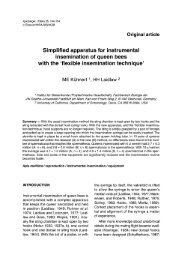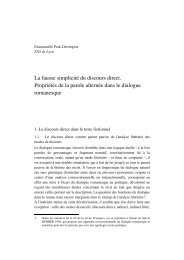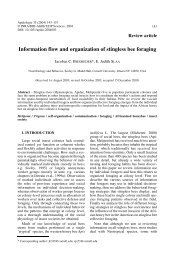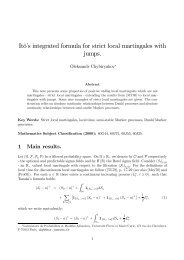ARBEITSGEMEINSCHAFT DER INSTITUTE FÜR ... - HAL - INRIA
ARBEITSGEMEINSCHAFT DER INSTITUTE FÜR ... - HAL - INRIA
ARBEITSGEMEINSCHAFT DER INSTITUTE FÜR ... - HAL - INRIA
You also want an ePaper? Increase the reach of your titles
YUMPU automatically turns print PDFs into web optimized ePapers that Google loves.
SUMMARY<br />
Varroa jacobsoni and Tropilaelaps clarae in bee colonies of Apis mellifera<br />
Varroa jacobsoni and Tropilaelaps clarae are new parasites of the honey bee,<br />
Apis rnellifera, in Southeast Asia. A non-adaptable host-parasite relationship can<br />
lead to considerable bee damage. Although both mites are present in Thailand,<br />
colonies are usually infested with only 1 of the 2 parasites. The infestation of<br />
adult bees and brood by Varroa jacobsoni was larger the more recent the last<br />
treatment with an acaricide had been carried out, which occured 10 day<br />
intervals. Varroa jacob.soni was almost totally repressed by Tropilaelaps clarae<br />
in colonies left untreated for 2 years. Therefore, the repression of Tropilaelaps<br />
I<br />
clarae by Varroa jacobsoni is purely artificial. In contrast, the reverse process of<br />
repression is the natural one.<br />
A reason for the repression of the parasite may be due to different reproduction<br />
rates. The reproduction curves for parasites in worker brood differ significantly.<br />
The time of appearance and the number of develo>mental stages of Varroa<br />
jacobsoni, correspond largely with those found by IFANTIDIS (1983) in Europe. In<br />
contrast to Varroa jacobsoni, Tropilaelap.s clarae, only lays eggs shortly after<br />
sealing of brood cells. Not only is the second egg laid male, but female and male<br />
eggs are laid in approximately equal numbers. Varr-oa females and Tropilaelaps<br />
females produced 68 % and 71 % surviving offspring, respectively. The reproduction<br />
coefficient of all mites with respect to the brood was 1,27 for Varroa<br />
jacobsoni and 1,02 for Tropilaelaps clarae. Therefore, Tropilaelaps clarae<br />
produced significantly fewer offspring. A faster increase in the population of Tropilaelaps<br />
clarae can be explained by the fact that they survive outside of<br />
brood cells 1 or 2 days only (W OYKE , 1985). So they have to enter brood cells for<br />
reproduction in this period. The female was more frequently infertile in cells<br />
simultaneously infested with both parasites than in those only infested with 1<br />
parasite. The chance for Varroa jacobsoni to reproduce becomes smaller with an<br />
increase in the population of Tropilaelaps clame. This could be a reason for<br />
the repression of this parasite.<br />
RÉSUMÉ<br />
Varroa jacobsoni et Tropilaelaps clarae<br />
dans le.s colonies d’abeille.s Apis mellifica en Thaïlancfe<br />
Varroa jacobsoni et Tropilaelaps clarae sont de nouveaux parasites de<br />
l’abeille, Apis mellifica, dans le sud-est asiatique. Une relation hôte-parasite non<br />
adaptée peut conduire à des dégâts considérables chez les abeilles. Bien que les




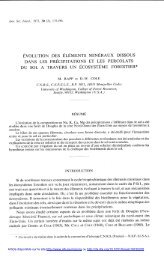
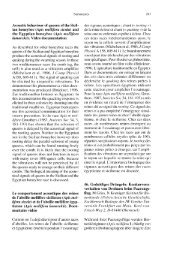
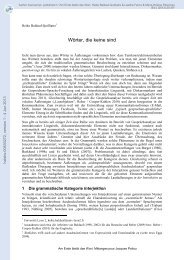
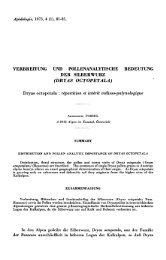
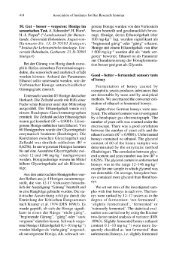
![4 C]-Polyethylenglykol bestimmt, der - HAL - INRIA](https://img.yumpu.com/22454280/1/177x260/4-c-polyethylenglykol-bestimmt-der-hal-inria.jpg?quality=85)
